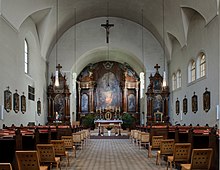Capuchin monastery Vienna

The Capuchin monastery Vienna is a branch of friars of the Capuchin in Vienna . Together with the Capuchin Church, it is located in downtown Vienna on the Neuer Markt . The Kapuzinergruft , the burial place of the Habsburgs, extends under the monastery complex .
history
The monastery of the Capuchin Order in Vienna, including the monastery church and imperial crypt, was founded in 1618 by Empress Anna (1585–1618), the wife of Emperor Matthias (1557–1619), in a will. Under Ferdinand II. (1578–1637) the foundation stone was laid on September 8, 1622 at what was then the flour market or at the flour pit . Construction began in 1622. Due to the Thirty Years' War , work was delayed and the church could not be completed until 1632.
In the 17th century, the preacher Marco d'Aviano , later beatified , lived in the Capuchin monastery and is buried in the Capuchin Church. On the outer wall of the Capuchin monastery, a larger than life statue reminds of him. On June 7, 1766, the Capuchin General Minister Paul von Colindres died here ; he was also buried in the church. Church and monastery were often rebuilt; the facade of the church was reconstructed from historical images between 1934 and 1936.
monastery
After it was founded on the basis of the will of Empress Annas , the Capuchin Monastery in Vienna experienced eventful years, which had given the monks particularly glamorous and difficult times. At the beginning of the 19th century, when the monastic community was threatened with extinction, consideration was given to relocating the burial place of the Habsburgs to the nearby Augustinian Church , but this ultimately did not materialize. In the years 1840–1842 the dilapidated monastery was torn down under Emperor Ferdinand I and rebuilt in its current form. The Capuchin Monastery in Vienna is part of the Austrian Capuchin Province with its seat in Innsbruck.
In contrast to the Capuchin Crypt and the Capuchin Church, the rooms of the monastery are not open to the public, apart from occasional exhibitions.
church
The simple single-nave church of the Capuchin monastery in Vienna has the patronage "Saint Mary of the Angels" and has a small vestibule and two side chapels: the imperial chapel, which, in contrast to the simple design of the rest of the monastery church, is splendidly furnished, and the Pietà chapel, which houses the grave of the blessed Marco d'Aviano is located.
Crypt
The Capuchin Crypt , the most important burial place of the Habsburgs, extends under the monastery complex . The crypt system has been expanded and expanded a total of eight times over the centuries. The oldest part, the so-called Founder's Crypt , is located approximately below the Imperial Chapel. Until the death of Emperor Charles VI. (1740) the crypt had already been expanded so far that it extended below the entire monastery church. Soon after taking office, his successor, Maria Theresa , had another expansion carried out, for which both an underground and above-ground structure was built behind the chancel of the monastery church and the monastery garden was reduced accordingly. For the later extensions of the crypt, the former basement rooms of the monastery were mostly adapted.
Web links
Individual evidence
- ^ Johann Joseph von Khevenhüller-Metsch : From the time of Maria Theresa: Diary of Prince Johann Josef Khevenhüller-Metsch, Imperial Obersthofmeister 1742–1776 , 1917, p. 186, (detail scan)
- ^ Günther Buchinger, Christa Farka: Vienna: I. District - Inner City. Institute for Austrian Art Research of the Federal Monuments Office, Vienna, 2003, ISBN 3-85028-366-6 , p. 81; (Detail scan)
- ↑ Magdalena Hawlik-van de Water: The Capuchin Crypt. Burial place of the Habsburgs in Vienna. 2nd Edition. Vienna 1993, p. 30.
- ↑ kulturgueter.kath-orden.at
- ↑ sakralbauten.at
Coordinates: 48 ° 12 ′ 20 ″ N , 16 ° 22 ′ 10.5 ″ E


